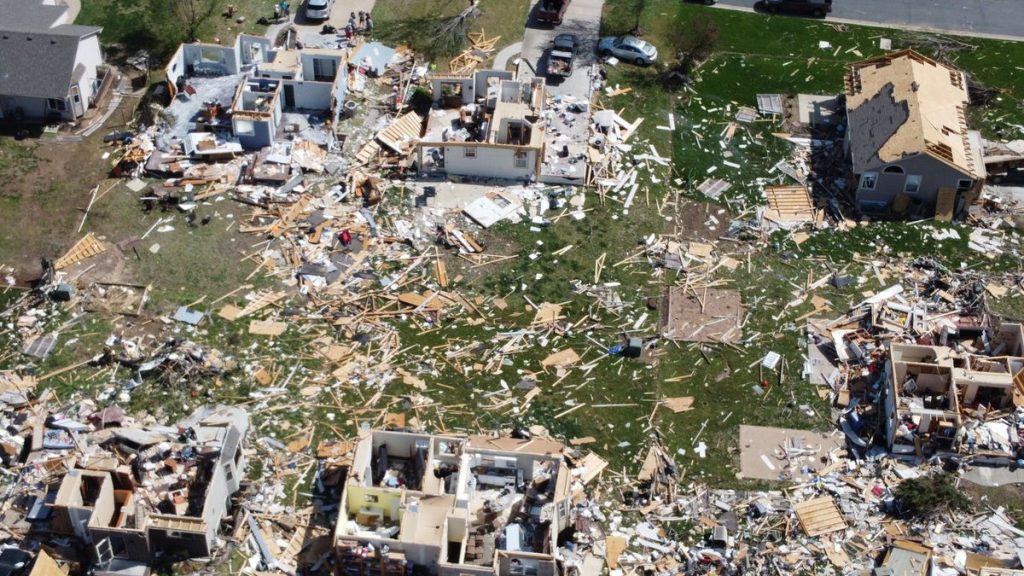More than half of at-home tornado deaths occur in mobile homes, state data shows

The Associated Press analyzed tornado deaths and found that since 1996, 53% of the tornado deaths in people’s homes were in mobile or manufactured housing. That’s even though manufactured homes are less than 6% of the American housing stock. It’s more than 800 deaths in mobile or manufactured homes.
And when tornadoes are weak — with winds of 135 mph or less — an even higher proportion of tornado deaths at home, 79%, are in mobile homes. This is a story that is easily localized, by looking at tornado deaths, mobile home rates and applicable federal rules in your state and counties.
TOP 10 STATES WITH TORNADO DEATHS
Below are publishable paragraphs about the 10 states with the most tornado deaths. We also include how many deaths were at home, the percentage of those at-home deaths in mobile or manufactured homes and the percentage of the state’s housing stock that are manufactured homes.
ALABAMA
Since 1996, Alabama leads the country by far with 396 tornado deaths, with 293 of them at home. Of those at-home deaths, 49.1% or 144, of them were in mobile or manufactured homes. Yet only 11% of Alabama’s housing stock are mobile homes.
MISSOURI
Since 1996, Missouri ranks second in the country with 252 tornado deaths, with 139 of them at home. Of those at-home deaths, 28.8% or 40, of them were in mobile or manufactured homes. Yet only 5.3% of Missouri’s housing stock are mobile homes.
TENNESSEE
Since 1996, Tennessee ranks third in the country by with 204 tornado deaths, with 176 of them at home. Of those at-home deaths, 47.7% or 84, of them were in mobile or manufactured homes. Yet only 7.5% of Tennessee’s housing stock are mobile homes.
MISSISSIPPI
Since 1996, Mississippi ranks fourth in the country with 137 tornado deaths, with 99 of them at home. Of those at-home deaths, 59.6% or 59, of them were in mobile or manufactured homes. Yet only 12.4% of Mississippi’s housing stock are mobile homes.
OKLAHOMA
Since 1996, Oklahoma ranks fifth in the country with 131 tornado deaths, with 86 of them at home. Of those at-home deaths, 44.2% or 38, of them were in mobile or manufactured homes. Yet only 7.7% of Oklahoma’s housing stock are mobile homes.
ARKANSAS
Since 1996, Arkansas ranks sixth in the country with 126 tornado deaths, with 97 of them at home. Of those at-home deaths, 53.6% or 52, of them were in mobile or manufactured homes. Yet only 9.9% of Arkansas’ housing stock are mobile homes
KENTUCKY
Since 1996, Kentucky ranks seventh in the country with 117 tornado deaths, with 94 of them at home. Of those at-home deaths, 53.2% or 50, of them were in mobile or manufactured homes. Yet only 9.8% of Kentucky’s housing stock are mobile homes.
GEORGIA
Since 1996, Georgia ranks eighth in country with 111 tornado deaths, with 104 of them at home. Of those at-home deaths, 76% or 79, of them were in mobile or manufactured homes. Yet only 7.5% of Georgia’s housing stock are mobile homes.
TEXAS
Since 1996, Texas ranks ninth in the country with 106 tornado deaths, with 77 of them at home. Of those at-home deaths, 51.9% or 40, of them were in mobile or manufactured homes. Yet only 6.1% of Texas’ housing stock are mobile homes.
FLORIDA
Since 1996, Florida ranks tenth in the country with 81 tornado deaths, with 67 of them at home. Of those at-home deaths, 86.6% or 58, of them were in mobile or manufactured homes. Yet only 7.5% of Florida’s housing stock are mobile homes.
SOURCES: NOAA, U.S. Census Bureau
VIEW DATA FOR YOUR STATE
This spreadsheet includes data for these 35 states, which had deaths during tornadoes that occurred at home since 1996. Use it to find out how many tornado deaths have occurred at home in each state, broken down by permanent homes and manufactured homes, what percentage of tornado deaths in people’s homes have been in mobile homes, and what percentage of residents in each state lives in mobile homes.
https://interactives.ap.org/localize-it/2023/tornado-home-deaths/tornado-home-deaths.csv
CONSIDER THESE QUESTIONS
What emergency shelter plans are in place in your communities for mobile home residents during a tornado?
What warning systems do your communities have when a tornado is approaching or has touched down?
Do stricter U.S. Department of Housing and Urban Development rules for mobile homes (in hurricane prone areas) apply? (See LEARN MORE ABOUT WIND ZONES below)
Are people who live in manufactured homes in your area aware of additional risks if homes are not anchored to the ground? Consider asking community members about this as well as local mobile home retailers.
LEARN MORE ABOUT WIND ZONES AND DESIGN STANDARDS
One of the big problems, according to researchers, is that the federal HUD rules that call for tougher manufactured home standards, including anchoring mobile homes to the ground, apply only in hurricane zones, which is most of Florida and several counties along the coast. Those are not the areas where tornadoes usually hit. They hit inland where the weakest federal standards are, researchers told the AP. Most of tornado-prone areas, including almost all of Alabama, Oklahoma, Missouri, Texas and Mississippi are in Zone 1 with the most lax standards.
Also, those installation standards are based on hurricane winds, which are straight line winds and are vastly different than tornadoes’ vertical lifting winds that are often stronger.
This map labels the different wind zones that correspond to stricter design requirements: https://www.air-worldwide.com/blog/posts/2015/2/manufactured-modular-and-mobile-homes-whats-in-a-name/
The list of counties in Wind Zones II and III (all others are in Wind Zone I) is here in federal code in 3280.305 (c) (2): https://www.ecfr.gov/current/title-24/subtitle-B/chapter-XX/part-3280
The most stringent requirements are in Wind Zone III: That’s all of Hawaii, coastal Alaska, 14 counties in southern and southwest Florida (Broward, Charlotte, Collier, Dade, Franklin, Gulf, Hendry, Lee, Martin, Manatee, Monroe, Palm Beach, Pinellas and Sarasota), eight parishes in Louisiana (Jefferson, La Fourche, Orleans, Plaquemines, St. Bernard, St. Charles, St. Mary and Terrabonne), three counties in North Carolina (Carteret, Dare and Hyde) and all of American Samoa, Guam, Northern Mariana Islands, Puerto Rico and the U.S. Virgin Islands.
Slightly weaker requirements are in Baldwin and Mobile counties in Alabama, all the rest of Florida, six counties in Georgia (Bryan, Camden, Chatham, Glynn, Liberty and McIntosh), 26 parishes in Louisiana (Acadia, Allen, Ascension, Assumption, Calcasieu, Cameron, East Baton Rouge, East Feliciana, Evangeline, Iberia, Iberville, Jefferson Davis, LaFayette, Livingston, Pointe Coupee, St. Helena, St. James, St. John the Baptist, St. Landry, St. Martin, St. Tammany, Tangipahoa, Vermillion, Washington, West Baton Rouge and West Feliciana), two in Maine (Hancock and Washington), five in Massachusetts (Barnstable, Bristol, Dukes, Nantucket and Plymouth), six in Mississippi (George, Hancock, Harrison, Jackson, Pearl River and Stone), 16 in North Carolina (Beaufort, Brunswick, Camden, Chowan, Columbus, Craven, Currituck, Jones, New Hanover, Onslow, Pamlico, Pasquotank, Pender, Perquimans, Tyrrell and Washington), nine in South Carolina (Beaufort, Berkeley, Charleston, Colleton, Dorchester, Georgetown, Horry, Jasper and Williamsburg) 15 in Texas (Aransas, Brazoria, Calhoun, Cameron, Chambers, Galveston, Jefferson, Kenedy, Kleberg, Matagorda, Nueces, Orange, Refugio, San Patricio and Willacy), and five cities in Virginia (Chesapeake, Norfolk, Portsmouth, Princess Anne and Virginia Beach).
The rest of the country is in Wind Zone 1, where there are no extra strengthening rules.








